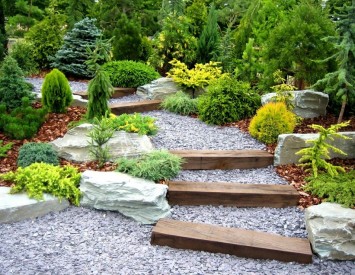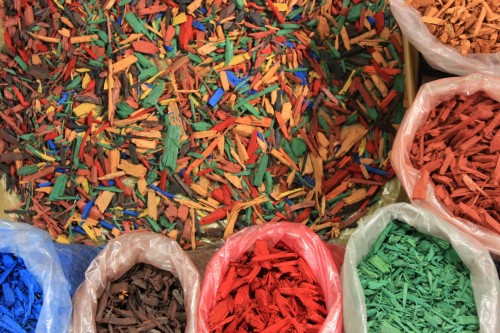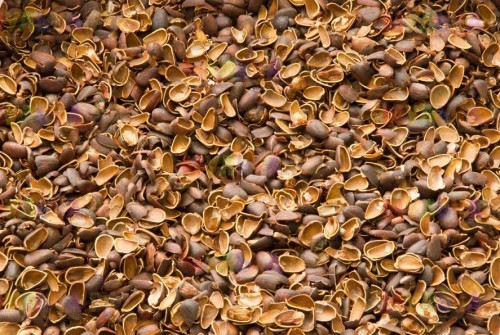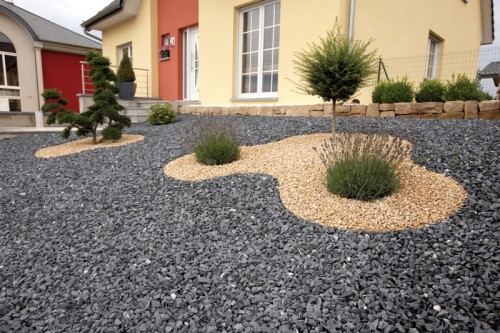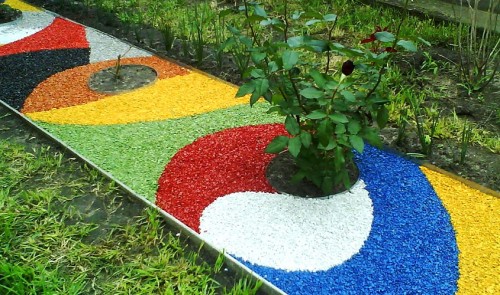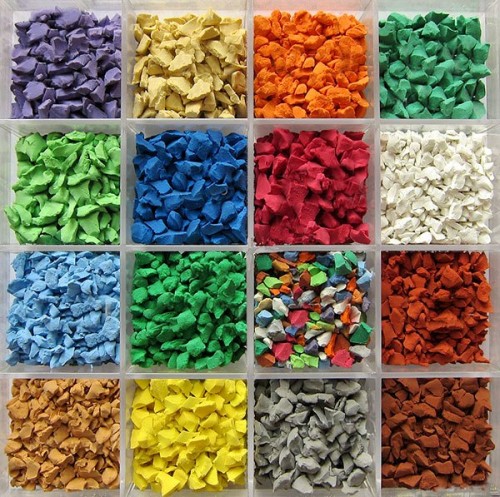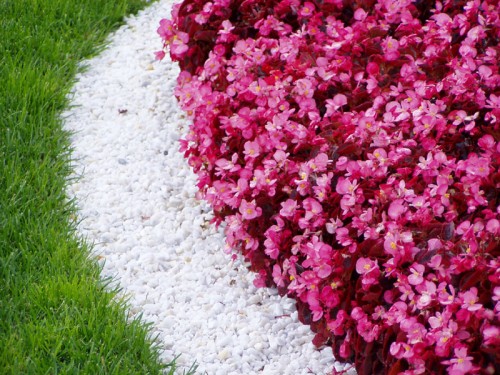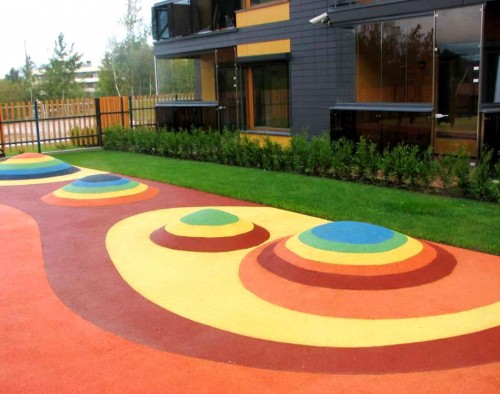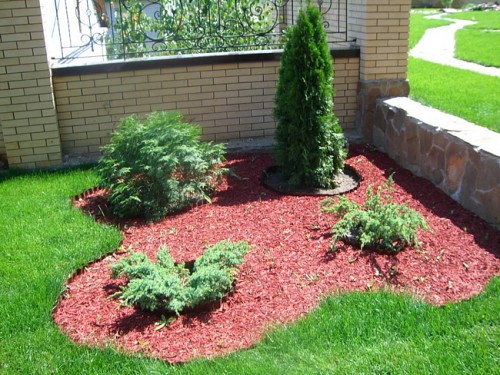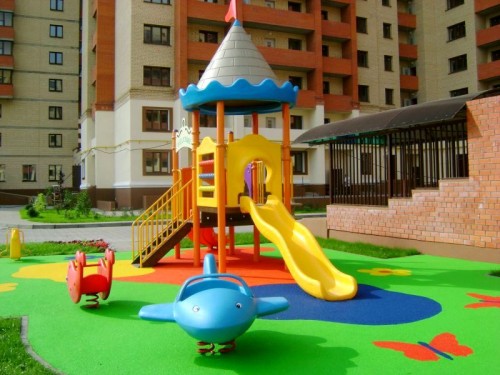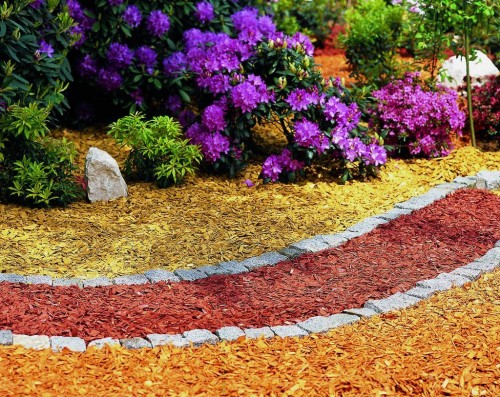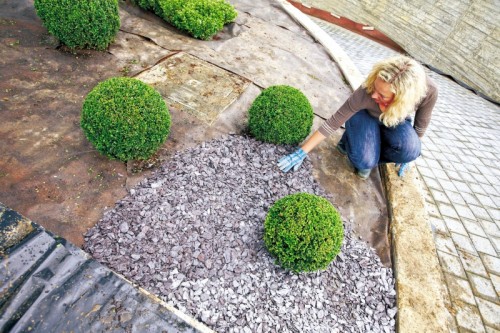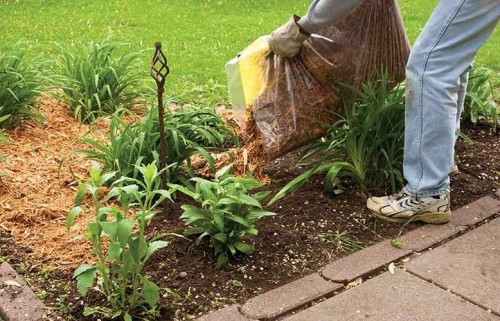The decorative semicircle is used in landscape design with the aim of giving the aestheticism and well-groomed garden territory. The most popular mulch today is multicolored, which is made from various wood species. This element in the country area allows you to diversify the landscape design, give the lawns, flower beds and paths an extraordinary and attractive look. Create personnel patterns and drawings from multicolored chips will not be difficult.
Content
A variety of decorative chips
The mulch decorative is used both to decorate the green garden, and for the framing paths, which allows you to create comfortable and artistic decorated compositions. In addition, different types of chips also perform practical functions. Consider in more detail what materials are used as mulch for decoration.
Decorative mulch
The decorative chip is the material from natural wood. It is used to decorate the soil in park areas, decorating flower beds, shrubs and flower beds. It is also often used to finish children's zones, because the material is carefully processed and does not carry danger during operation. Mulch decorative to buy in specialized stores and constructionarkets, where chips are represented in color variety. In addition, the technical and aesthetic characteristics of the coating are suitable for the amusing of pleasure, sports or park tracks, since such chips have drainage abilities and quickly misses moisture. Thanks to this, the tracks are always clean, soft and have an attractive appearance.
Cedar shell
Shell of cedar nuts - practical and durable mulch material, which has a unique aroma and shine. Thanks to the protective antiseptic properties of the shell, it does not rot for a long time, which makes the coating reliable and economical. With a certain grinding, such a chickel naturally stimulates the development of microflora and increases the air permeability of the soil. And due to the variety of color solutions and the size of the fraction, the shell is used to decorate land areas, park zones and swelling of pleasure paths.
Chip from the bark of coniferous plants
The chip from the crust has a high aesthetic value and variations in size, which allows you to expand the range of mulching. In particular, the chip from larch due to its natural reddish shade is valued. Unlike traditional mulching components, this decorative chip-mulch is used exclusively in natural color.
Decorative gravel
Gravel - a variety of inorganic mulch, which is used to assist the walking parks on the household territory, finishing shrubs, driveways or steps. In particular, gravel is appreciated when decorating artificial alpinarians - mountain landscape zones with a reservoir. The variety of material varies in colors, texture and size. In addition, gravel has a number of advantages: it does not blown away by the wind, prevents the growth of weeds and retains heat.
Glass mulch
Glass crumb - such a type of mulch has an extraordinary appearance, and thanks to special processing technology, all edges of fragments are smoothed and do not represent dangers when used. The glass mulch does not absorb moisture, so it is used to decorate shrubs, flower and flower arrangements.
Rubber crumb
Rubber mulch - practical and durable material, which has its advantages: it reliably keeps moisture, inhibits the growth of weeds, fungal or moldless formations. And also on such a decorative mulch, the price is significantly lower than one other analogues. It is used for decorating flower beds of any type.
Marble mulch
The crumb of marble stone is a unique material having various variations in the size of fragments. This mulch is highlighted in beautiful appearance and ecology. Due to the color variety, the marble crumb is organically combined with any landscape design. And this material is especially valued when decoking the streams, alpine slides, walking paths and artificial reservoirs.
Effects achieved when mulching
- The decorative pinch reliably protects the roots of the plantations, passing the necessary moisture and air, maintaining the soil in loose state.
- The mulch allows you to save on watering plants, due to the high ability to hold moisture.
- The material protects the soil from erosion, because it does not allow to blow the soil with wind.
- The mulch performs the role of a natural adsorbent, pulling out toxic substances from the soil and conducive to the active growth of greenery.
- Promotes breeding in the ground of rainwoods and useful microorganisms.
- Decorative chips inhibits the growth of weed plants, due to which a smaller care is required.
- In the summer, the seams protect the roots of the plantings from overheating, and in the winter months - from supercooling.
- The decorative chips is easy to operate and practically does not require care.
- Such a decor gives an ordinary garden area quite aesthetic, artistic appearance.
Decorating chipped landscape
Mulch is an original and durable material used in the design of landscape design. Such a coating is harmonized with the use of materials such as stone, pebbles and bark. Due to the vast variety of species and colors of the material, it can be used to decorate flower beds, pleasure tracks, shores of artificial reservoirs. Often, the chips are suitable for the framing of handicrafts and trees, since the plant "ocelled" bright pinch looks much more attractive. As necessary, it is also possible to disguise the unpleasant corners on the household territory, falling asleep by their chipping different color variations.
Decorative mulch is the best option for decorating sports and walking tracks. Special characteristics of the material allow you to maintain aesthetic look of paths in slush or rain, thanks to high bandwidth. Run and walk along the tracks will be comfortable and safe.
Material is also ideal for rising territory on the playground. In addition to the fact that the mulch remains clean and dry, regardless of the weather, the coating also softens the blows during the fall, protects children from injury, abrasion and scratches. And bright decoration always pleases the eyes of young researchers.
Decorative mulch is used to transplant old perennial plants. Since perennials are planted at a certain distance from each other, this space can be beautifully embedded with chip in different variations.
Examples of work that used decorative chips in the photo and video can be viewed here:
The process of laying mulch
In order to create an original design of the household territory with the use of mulch, it is originally necessary to enrich the soil and plant plants. When refining a piece of decorative chips, special skills will not be required. The whole procedure comes down to such actions:
- The soil on the land must be switched, explode and remove all weeds.
- Then think the design: color, shape, mulch type.
- Follow the contours on the ground on the planned figure.
- Squeeze the chip and thoroughly scatter, so that the shallow layer is out of 3 to 6 cm.
- Every year, plunge 1 cm fresh chips.
Mandatory requirements for chips
- Depending on the type of chips, the layer must reach from 3 to 12 cm.
- It is preferable to decorate wet soil, i.e. Immediately after the rain.
- Between the coating and stems of plantations, it is recommended to leave a small gap to favor oxygen circulation.
- At sunny sections of the garden, the mulch layer must be somewhat thicker than on shaded.
Mulsed zone care
Decorative seams - quite practical material in operation, which requires knowledge of some features at a resignation. So, the mulching of early spring is extremely not recommended, since the soil is not yet funded and the appearance of rot during protracted rainfall. To lay chips, it is necessary to make sure that the soil is enough to be seized and the most favorable period is the end of spring.
The dusting of the soil decorative chip allows you to save the desired temperature of the soil near the roots of the plantation, eliminating the risk of contrasting oscillations. But, if you leave a mulch for the winter, then it will serve as a beneficial medium for rainwood and organic microflora. As a result, they recycle a mulch of natural origin and turn it into humus. Therefore, in the spring, the top layer of chips must be shifted and added to the new, 1-2 cm high.
The chip laying process can be seen on the video:
